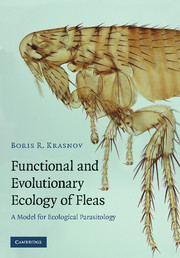Book contents
- Frontmatter
- Contents
- Preface
- Part I Brief descriptive ecology: what do fleas do?
- Part II Functional ecology: how do fleas do what they do?
- Part III Evolutionary ecology: why do fleas do what they do?
- 14 Ecology and evolution of host specificity
- 15 Ecology of flea populations
- 16 Ecology of flea communities
- 17 Patterns of flea diversity
- 18 Fleas, hosts, habitats
- 19 What further efforts are needed?
- References
- Index
14 - Ecology and evolution of host specificity
Published online by Cambridge University Press: 14 August 2009
- Frontmatter
- Contents
- Preface
- Part I Brief descriptive ecology: what do fleas do?
- Part II Functional ecology: how do fleas do what they do?
- Part III Evolutionary ecology: why do fleas do what they do?
- 14 Ecology and evolution of host specificity
- 15 Ecology of flea populations
- 16 Ecology of flea communities
- 17 Patterns of flea diversity
- 18 Fleas, hosts, habitats
- 19 What further efforts are needed?
- References
- Index
Summary
Host specificity is one of the fundamental properties of any parasitic organism. Highly host-specific parasites exploit a single host species, whereas host-opportunistic parasites use hosts belonging to several different species. Consequently, from an ecological perspective, host specificity is nothing other than the breadth of ecological niche of a parasite, representing the diversity of resources used by it (Futuyma & Moreno, 1988). From an evolutionary perspective, host specificity reflects the parasite's historical associations with its hosts (Brooks & McLennan, 1991; Page, 2003). In this chapter I discuss patterns of host specificity in fleas, starting with how to measure it and reviewing the patterns of host specificity found in fleas. I go on to consider the relationships between degree of host specificity and evolutionary success in fleas and discuss the evolutionary forces that determine selection for either high or low host specificity. Finally, I address some applicative questions that involve investigations of flea host specificity.
Measures of host specificity
Intuitively host specificity can be defined merely as the number of host species that are used by a parasite population or species. However, even host-opportunistic (=host generalist) parasites do not use all the variety of their hosts equally, but rather some host species are used more intensely than others. Accordingly, several attempts to introduce some ecological information (e.g. prevalence and/or abundance of a parasite in different host species) into a single index of host specificity have been made.
Information
- Type
- Chapter
- Information
- Functional and Evolutionary Ecology of FleasA Model for Ecological Parasitology, pp. 283 - 320Publisher: Cambridge University PressPrint publication year: 2008
